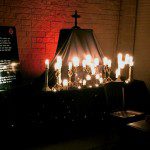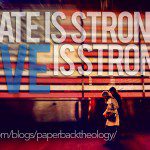 I’m reading Pilgrim at Tinker Creek by Annie Dillard, and continuing to reflect upon the nature of prayer and the presence of God. If you dive into this work, you have to know Dillard spends an inordinate amount of the book reflecting on the minutiae of the ordinary–the intricate details of nature of which she is an astute student. It’s a contemplative thing to read her work, so you kinda have to be in the mood.
I’m reading Pilgrim at Tinker Creek by Annie Dillard, and continuing to reflect upon the nature of prayer and the presence of God. If you dive into this work, you have to know Dillard spends an inordinate amount of the book reflecting on the minutiae of the ordinary–the intricate details of nature of which she is an astute student. It’s a contemplative thing to read her work, so you kinda have to be in the mood.
Nevertheless, it did win the 1975 Pulitzer, so you know there’s something there worth your time to investigate. Larry Freundlich, the editor in chief at Harper’s, who published the book, said after reading PATK for the first time: “I never expected to see a manuscript this good in my life.” You can tell from the first sentence that you are reading something unlike most works. Still, I would love to know how many people have started reading PATK and put it down after fifteen minutes saying, “What the hell was that?”
As I read today I was struck by her portrayal of the wildness of creation. Creation is untamed, and there is something of the nature of God in this unbridled power. Those who seek to be still among the roiling creation must know that they are, at least in a sense, working against nature–at least the part of nature we are built out of. This kind of interaction–stillness, silence, solitude amongst the amoral wild and free wilderness–surely has its dangers. It can inspire a kind of madness to chase the horizon.
Dillard tells this story about Eskimos who sit silently in their kayaks waiting for the seals to surface in the water of Greenland’s fjords, water so still it looks like a sheet of glass. The mirror-like water reflects a vivid sky that sometimes becomes so bright and life like that the world seems upside down. The effect is dizzying, even paralyzing to some, and they often fall right into the water out of fear and disorientation. Too much light. In others it causes a panic so debilitating that, for those who are prone to it, they cannot go back into the water; which means they cannot feed their families.
Dillard’s point is a good one. We need to be at least a little bit careful about what we hope to experience, and especially about what we claim to be experiencing. We must be wise in considering the lengths to which we will go in order to see God. We cannot will ourselves into a trance and call that flying. We cannot decide we would like a special manifestation of God’s presence, and then set about conjuring it up. About all we can do is creep to the edge of the canyon and watch the sun just before it comes up. Stare too long and you will probably go blind.
“The vision comes and goes, mostly goes,” she writes. Most of the time we can’t see God, we can only see where God was. For me the real question this leaves me with is, why? Why does it go? What possible good could there be to having the vision of God go? Maybe it is because too much of a good thing can be our undoing. Perhaps we were not meant to gaze into the abyss unless we’ve made our bed, brushed our teeth, put our dishes away, and chopped the wood. Partly because this is not the center of the human vocation, and partly because we are not equipped with the kind of faculties it would require for too much of this good thing. It’s just that dizzying, that paralyzing.
I have often watched as people set off on their path toward God forgetting the reality of fits and starts. Forgetting that we have a lousy innate sense of direction that often gets turned around and confused. We are prone to becoming so lost that we are not clear about which way is up, and which way is down. We’re apt to choose the wrong one at the wrong time, even for all the right reasons.
“The vision comes and goes, mostly goes, but I live for it.” What I take this to mean is not that God gets off on being withholding. It’s just that too much seeing would be our undoing. We would become overconfident and start to play God. This is one of the two ways humanity always disintegrates. Either we start to worship creation, or we start to think we are God.
Yet in the rare and precious flashes of brilliance in which we catch a glimpse of the divine, there is a lasting power. Part of why we know that the presence of God is rare is because it marks us so indelibly. Dillard describes her experience as a “seeing” for the first time in a way she had never before seen, and although the experience is rare, its impact lasts for awhile. “The flood of fire abated,” she writes, “but I’m still spending the power.” (p.33)
The type of encounter with God Annie Dillard is describing is anything but mundane. We cannot experience this sort of seeing, this sort of presence every single day. So we cannot engage our prayer practices and spiritual disciplines as though we will. You cannot force God’s hand. Ask the prophets of Baal who danced and wailed and cut themselves only to find their god sleeping through it. You cannot trick God into showing up with a perfect lotus position, a nature walk, contemplative prayer, yoga, LSD, or whatever your game. It doesn’t work like that. We need do those things which help us to clean the muck off our soul, to prepare our hearts to receive God’s presence when it shows up in power. But we are not the light we are the mirror. We are not the One, we are the reflection of the One. So most of the time when we pray it feels like nothing is happening. We need to learn to be okay with that. More is happening that we could ever imagine. Dillard might be the best in the world at teaching that very reality.












